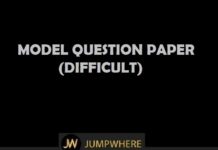Explanation/ Important formulas:
Instruction:
- The logic problems in this set present you with three true statements: Fact 1, Fact 2, and Fact 3. Then, you are given three more statements and you must determine which of these, if any, a fact is also.
- One or two of the statements could be true; all of the statements could be true; or none of the statements could be true.
- Choose your answer based solely on the information given in the first three facts.
Instructions to take Aptitude Test
Click on start to start taking the test.
Click on the option (A, B, C or D) to figure out the right answer.
You can answer multiple times till you get the right answer.
Once you get the right answer, explanations (if any) for the same will be showcased down.
On click of list, you get to see total no of questions, no of questions you answered and no of questions pending to answer.
On click of question number you will go to that particular question.
On click of END your test will end.
On click of ‘Get Results’ you will get to see correct answer for each questions.
Logical Problems - Test
Logical Problems
You scored %%SCORE%% out of %%TOTAL%%.
Your performance has been rated as %%RATING%%
|
Question 1
|
I) All Lamels are Signots with buttons.
II) No yellow Signots have buttons.
III) No Lamels are yellow.
If the first two statements are true, the third statement is
|
True
|
|
|
False
|
|
|
Uncertain
|
Therefore, Lamels do not have buttons and cannot be yellow
|
Question 2
|
I) The hotel is two blocks east of the drugstore.
II) The market is one block west of the hotel.
III) The drugstore is west of the market.
If the first two statements are true, the third statement is
|
True
|
|
|
False
|
|
|
Uncertain
|
The drugstore is two blocks west of the hotel, so the drugstore is west of the market.
|
Question 3
|
I) A toothpick is useful.
II) Useful things are valuable.
III) A toothpick is valuable.
If the first two statements are true, the third statement is
|
True
|
|
|
False
|
|
|
Uncertain
|
|
Question 4
|
I) Tom puts on his socks before he puts on his shoes.
II) He puts on his shirt before he puts on his jacket.
III) Tom puts on his shoes before he puts on his shirt.
If the first two statements are true, the third statement is
|
True
|
|
|
False
|
|
|
Uncertain
|
|
Question 5
|
I) Three pencils cost the same as two erasers.
II) Four erasers cost the same as one ruler.
III) Pencils are more expensive than rulers.
If the first two statements are true, the third statement is
|
True
|
|
|
False
|
|
|
Uncertain
|
|
Question 6
|
I) Taking the train across town is quicker than taking the bus.
II) Taking the bus across town is slower than driving a car.
III) Taking the train across town is quicker than driving a car.
If the first two statements are true, the third statement is
|
True
|
|
|
False
|
|
|
Uncertain
|
|
Question 7
|
I) Cloudy days tend to be more windy than sunny days.
II) Foggy days tend to be less windy than cloudy days.
III) Sunny days tend to be less windy than foggy days.
If the first two statements are true, the third statement is
|
True
|
|
|
False
|
|
|
Uncertain
|
|
Question 8
|
I) At a parking lot, a sedan is parked to the right of a pickup and to the left of a sport utility vehicle.
II) A minivan is parked to the left of the pickup.
III) The minivan is parked between the pickup and the sedan.
If the first two statements are true, the third statement is
|
True
|
|
|
False
|
|
|
Uncertain
|
|
Question 9
|
I) The bookstore has a better selection of postcards than the newsstand does.
II) The selection of postcards at the drugstore is better than at the bookstore.
III) The drugstore has a better selection of postcards than the bookstore or the newsstand.
If the first two statements are true, the third statement is
|
True
|
|
|
False
|
|
|
Uncertain
|
|
Question 10
|
I) A jar of jelly beans contains more red beans than green.
II) There are more yellow beans than red.
III) The jar contains fewer yellow jelly beans than green ones.
If the first two statements are true, the third statement is
|
True
|
|
|
False
|
|
|
Uncertain
|
|
Question 11
|
I) Tanya is older than Eric.
II) Cliff is older than Tanya.
III) Eric is older than Cliff.
If the first two statements are true, the third statement is
|
True
|
|
|
False
|
|
|
Uncertain
|
|
Question 12
|
I) Blueberries cost more than strawberries.
II) Blueberries cost less than raspberries.
III) Raspberries cost more than strawberries and blueberries.
If the first two statements are true, the third statement is
|
True
|
|
|
False
|
|
|
Uncertain
|
|
Question 13
|
I) All the trees in the park are flowering trees.
II) Some of the trees in the park are dogwoods.
III) All dogwoods in the park are flowering trees.
If the first two statements are true, the third statement is
|
True
|
|
|
False
|
|
|
Uncertain
|
|
Question 14
|
I) Mara runs faster than Gail.
II) Lily runs faster than Mara.
III) Gail runs faster than Lily.
If the first two statements are true, the third statement is
|
True
|
|
|
False
|
|
|
Uncertain
|
|
Question 15
|
I) Apartments in the Riverdale Manor cost less than apartments in The Gaslight Commons.
II) Apartments in the Livingston Gate cost more than apartments in the Gaslight Commons.
III) Of the three apartment buildings, the Livingston Gate costs the most.
If the first two statements are true, the third statement is
|
True
|
|
|
False
|
|
|
Uncertain
|
|
Question 16
|
I) All Lamels are Signots with buttons.
II) No yellow Signots have buttons.
III) No Lamels are yellow.
If the first two statements are true, the third statement is
|
True
|
|
|
False
|
|
|
Uncertain
|
|
Question 17
|
I) The hotel is two blocks east of the drugstore.
II) The market is one block west of the hotel.
III) The drugstore is west of the market.
If the first two statements are true, the third statement is
|
True
|
|
|
False
|
|
|
Uncertain
|
|
Question 18
|
I) A toothpick is useful.
II) Useful things are valuable.
III) A toothpick is valuable.
If the first two statements are true, the third statement is
|
True
|
|
|
False
|
|
|
Uncertain
|
|
Question 19
|
I) Tom puts on his socks before he puts on his shoes.
II) He puts on his shirt before he puts on his jacket.
III) Tom puts on his shoes before he puts on his shirt.
If the first two statements are true, the third statement is
|
True
|
|
|
False
|
|
|
Uncertain
|
|
Question 20
|
I) Three pencils cost the same as two erasers.
II) Four erasers cost the same as one ruler.
III) Pencils are more expensive than rulers.
If the first two statements are true, the third statement is
|
True
|
|
|
False
|
|
|
Uncertain
|
|
Question 21
|
Fact 1 : All dogs like to run
Fact 2 : Some dogs like to swim
Fact 3 : Some dogs look like their masters.
If the first three statements are facts, which of the following statements must also be a fact ?
I:All dogs who like to swim look like their masters
II:Dogs who like to swim also like to run
III:Dogs who like to run do not look like their masters
|
I only
|
|
|
II only
|
|
|
II and III only
|
|
|
None of the statements is a known fact.
|
|
Question 22
|
Fact 1 : Jessica has four children
Fact 2 : Two of the children have blue eyes and two of the children have brown eyes
Fact 3 : Half of the children are girls.
If the first three statements are facts, which of the following statements must also be a fact?
I:At least one girl has blue eyes
II:Two of the children are boys
III:The boys have brown eyes
|
I only
|
|
|
II only
|
|
|
II and III only
|
|
|
None of the statements is a known fact.
|
|
Question 23
|
Fact 1 : All drink mixes are beverages
Fact 2 : All beverages are drinkable
Fact 3 : Some beverages are red.
If the first three statements are facts, which of the following statements must also be a fact?
I : Some drink mixes are red.
II : All beverages are drink mixes
III : All red drink mixes are drinkable
|
I and II only
|
|
|
II only
|
|
|
I and III only
|
|
|
III only
|
|
|
None of the statements is a known fact.
|
|
Question 24
|
Fact 1 : All chickens are birds
Fact 2 : Some chickens are hens.
Fact 3 : Female birds lay eggs.
If the first three statements are facts, which of the following statements must also be a fact?
I : All birds lay eggs.
II : Some Hens are birds
III : Some chickens are not hens.
|
I only
|
|
|
II only
|
|
|
II and III only
|
|
|
None of the statements is a known fact.
|
|
Question 25
|
Fact 1 : All hats have brims.
Fact 2 : There are black hats and blue hats.
Fact 3 : Baseball caps are hats.
If the first three statements are facts, which of the following statements must also be a fact?
I : All caps have brims.
II : Some baseball caps are blue.
III : Baseball caps have no brims.
|
I only
|
|
|
II only
|
|
|
II and III only
|
|
|
None of the statements is a known fact.
|
|
Question 26
|
I) A fruit basket contains more apples than lemons.
II) There are more lemons in the basket than there are oranges.
III) The basket contains more apples than oranges.
If the first two statements are true, the third statement is
|
True
|
|
|
False
|
|
|
Uncertain
|
Easy method: (Try this method to solve without any confusion)
=> A fruit basket contains more apples than lemons = App > Lem
=> There are more lemons in the basket than there are oranges = Lem > Org
=> Now, Combine the above two results: App > Lem > Org
=> The basket contains more apples than oranges (App > ... > Org) = Yes.
=> Therefore, the given 3rd statement is true.
|
Question 27
|
I) The Shop and Save Grocery is south of Greenwood Pharmacy.
II) Rebecca's house is northeast of Greenwood Pharmacy.
III) Rebecca's house is west of the Shop and Save Grocery.
If the first two statements are true, the third statement is
|
True
|
|
|
False
|
|
|
Uncertain
|
|
Question 28
|
I) Joe is younger than Kathy.
II) Mark was born after Joe.
III) Kathy is older than Mark.
If the first two statements are true, the third statement is
|
True
|
|
|
False
|
|
|
Uncertain
|
|
Question 29
|
I) On the day the Barton triplets are born,
II) Jenna weighs more than Jason.
III) Jason weighs less than Jasmine.
IV) Of the three babies, Jasmine weighs the most.
If the first two statements are true, the third statement is
|
True
|
|
|
False
|
|
|
Uncertain
|
|
Question 30
|
I) The temperature on Monday was lower than on Tuesday.
II) The temperature on Wednesday was lower than on Tuesday.
III) The temperature on Monday was higher than on Wednesday.
If the first two statements are true, the third statement is
|
True
|
|
|
False
|
|
|
Uncertain
|







